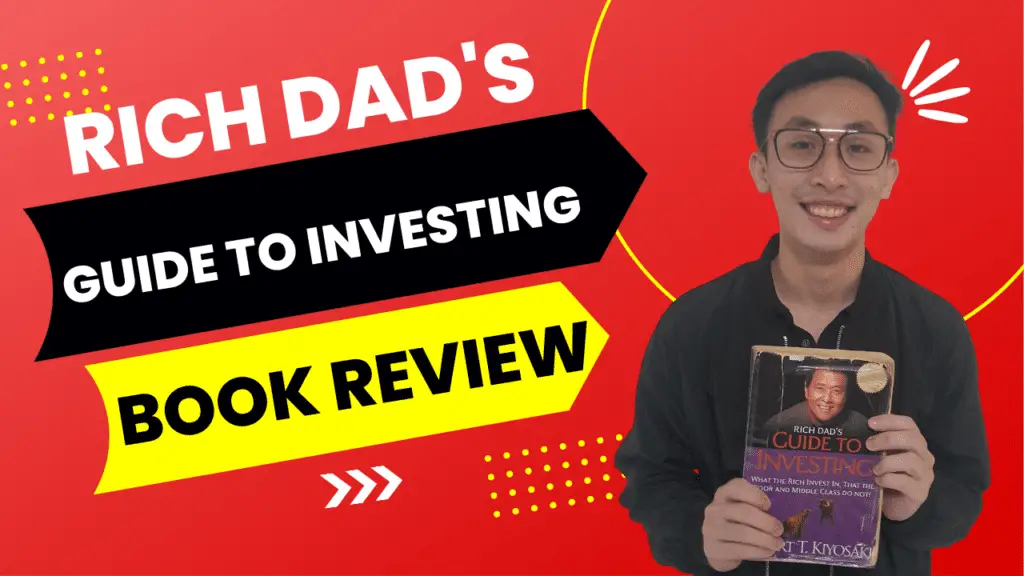Rich Dad Poor Dad books by Robert Kiyosaki is an award-winning book for beginners to learn about money-making. One of the main reasons most people should read Rich Dad Poor Dad is because they are most likely not thinking about money in the right manner.

Money isn’t merely a means for purchasing material goods, as the book makes abundantly clear. Not only that but what we like about the books also is it allows readers to understand sophisticated terms about investing.
The reviews will not be in-depth so you the potential readers would have something to read. Here are some takeaways from reading Rich Dad’s Guide to Investing.
Rich Dad Poor Dad Basic rules for investing
Now if you want to be like Robert Kiyosaki, listen up!
1. Understanding Rich Dad’s Principles
Robert Kiyosaki’s Rich Dad emphasizes the importance of financial education, taking calculated risks, and breaking free from the 9-to-5 mindset. By adopting these principles, individuals can build a strong foundation for their investment journey.
2. Analyzing Poor Dad’s Approach
While Rich Dad advocates for financial independence through investing, Poor Dad’s conventional mindset often prioritizes job security and steady income. We examine the contrasting approaches and highlight the potential drawbacks of playing it safe.
3. Diving into the World of Assets and Liabilities
One of the book’s fundamental concepts revolves around distinguishing between assets and liabilities. We explore the significance of acquiring income-generating assets and how they pave the way for long-term wealth.
4. The Power of Passive Income
Creating streams of passive income is at the core of Kiyosaki’s investment philosophy. We explore various passive income strategies, including real estate, dividend stocks, and online businesses, to help you design your passive income portfolio.
5. The Role of Entrepreneurship in Investing
Entrepreneurship and investing go hand in hand. At its core, entrepreneurship is all about identifying opportunities, taking calculated risks, and creating value. The same principles that drive entrepreneurs in their business ventures can be applied to the world of investing.
6. Debunking Common Investment Myths
Investing is a vital component of building wealth and securing financial futures. However, the world of investing is not without its fair share of myths and misconceptions.
These myths can mislead and discourage potential investors from taking advantage of the numerous benefits that come with investing. In this article, we will debunk some of the most common investment myths, providing you with accurate information to guide your investment journey.
Myth 1: Investing Is Only for the Wealthy
One of the most pervasive myths is that investing is only for the wealthy. In reality, anyone can become an investor, regardless of their income level. The key is to start small and be consistent with your investments. Many investment options, such as mutual funds or exchange-traded funds (ETFs), allow investors to begin with minimal amounts.
Myth 2: Investing Is Just Like Gambling
Some people equate investing with gambling, claiming that both involve taking risks. While it’s true that investing carries risks, the comparison is flawed. Unlike gambling, investing is based on careful analysis, research, and a long-term perspective. Successful investors make informed decisions and diversify their portfolios to manage risks effectively.
Myth 3: Market Timing Is the Key to Success
Timing the market to buy low and sell high is a tempting idea, but it is incredibly challenging to execute consistently. Even seasoned professionals struggle with market timing. Instead, successful investors focus on time in the market rather than trying to time the market. The power of compounding and staying invested for the long haul can yield impressive results.
Myth 4: High Returns Always Mean High Risk
While there is a correlation between risk and return, it’s not always a one-to-one relationship. High returns can be achieved with varying levels of risk. Diversification and careful asset allocation can help balance risk and reward in a portfolio.
Myth 5: You Need to Follow Stock Tips for Success
Following stock tips from friends, family, or online sources can be a recipe for disaster. Successful investing requires research, analysis, and a thorough understanding of your own financial goals and risk tolerance. Relying on stock tips without proper due diligence can lead to poor investment decisions.
7. Embracing Risk Management
Investing inherently involves risks, and successful investors understand that risk is an unavoidable part of the journey to financial growth. However, it’s not about avoiding risks altogether; it’s about managing them strategically. Embracing risk management is crucial for investors to protect their capital, achieve steady growth, and navigate through market uncertainties.
8. The Impact of Mindset on Investment Success
Having a positive mindset is vital for success in any endeavor, and investing is no exception. When investors maintain a positive outlook, they are more likely to stay focused, motivated, and resilient in the face of market fluctuations. A positive attitude helps to navigate challenges with a solution-oriented approach, rather than being overwhelmed by fear or anxiety.
9. Tax Strategies for Investors

Investing wisely is not just about making sound financial decisions; it’s also essential to consider the tax implications of your investment activities. Taxes can significantly impact your overall returns, so having a well-thought-out tax strategy is crucial for investors.
1. Utilize Tax-Advantaged Accounts
One of the most effective ways to reduce your tax burden as an investor is to take advantage of tax-advantaged accounts such as Individual Retirement Accounts (IRAs) and 401(k)s. Contributions made to these accounts are often tax-deductible, and the investments grow tax-free until withdrawal. By maximizing your contributions to these accounts, you can benefit from significant tax savings in the long run.
2. Long-Term Investing for Capital Gains
Investors can benefit from lower tax rates on long-term capital gains compared to short-term gains. Holding your investments for more than one year may qualify you for the reduced long-term capital gains tax rates. By adopting a long-term investment approach, you can minimize the taxes you pay on the profits earned from your investments.
3. Tax-Loss Harvesting
Tax-loss harvesting is a strategy where investors intentionally sell investments that have experienced losses to offset the gains from other investments. By doing so, you can reduce your overall taxable income. However, it’s essential to be mindful of the IRS’s “wash-sale” rule, which prohibits investors from repurchasing a substantially identical security within 30 days of selling it for tax-loss harvesting purposes.
4. Invest in Municipal Bonds
Municipal bonds, also known as “munis,” are debt securities issued by state and local governments. The interest income from these bonds is often exempt from federal taxes and, in some cases, state and local taxes as well. For investors in higher tax brackets, municipal bonds can be an attractive option to generate tax-free income.
5. Consider a Roth Conversion
If you have a traditional IRA or a 401(k) account, you may consider converting some or all of it to a Roth IRA. While you will pay taxes on the converted amount in the year of conversion, the funds in the Roth IRA will grow tax-free, and qualified withdrawals will be tax-free as well. This strategy can be particularly beneficial if you expect to be in a higher tax bracket during retirement.
6. Donating Appreciated Securities
Charitable giving can be an integral part of an investor’s financial plan. By donating appreciated securities instead of cash, you can potentially avoid paying capital gains taxes on the appreciation while still claiming a charitable deduction on your taxes. This can be a tax-efficient way to support your favorite causes.
7. Work with a Tax Professional
Navigating the complexities of the tax code can be challenging, especially when it comes to investments. Working with a qualified tax professional or financial advisor can provide valuable insights and ensure you are making the most of available tax strategies. They can help you tailor a tax plan that aligns with your investment goals and overall financial situation.
10. Navigating Market Volatility
Market fluctuations are inevitable, but they don’t have to be daunting. We provide insights on how to navigate market volatility and use it to your advantage.
11. Evaluating Investment Opportunities
Conducting thorough due diligence is essential when considering investment opportunities. We offer a step-by-step guide to help you evaluate potential investments effectively.
12. Real Estate Investing: Pros and Cons
Real estate is a popular investment avenue, but it comes with its pros and cons. We analyze the benefits and challenges of real estate investing to help you decide if it aligns with your financial goals.
13. Stock Market Strategies and Tips
The stock market can be intimidating for beginners, but we simplify the process with practical strategies and tips to help you navigate this dynamic market confidently.
14. Building a Diversified Investment Portfolio
Diversification is a key risk management tool. We discuss the importance of diversifying your investments across different asset classes to achieve a balanced portfolio.
15. Understanding Cryptocurrencies and Blockchain
Cryptocurrencies have emerged as a disruptive force in the financial world. We demystify the concept of cryptocurrencies and explore the underlying technology, blockchain, to help you make informed decisions.
16. Investing in Yourself
Investing in yourself is just as important as financial investments. We discuss the significance of continuous learning and personal development in your journey to financial freedom.
17. Investing with People
ESG investing aligns financial goals with sustainability and ethical values. We explore the benefits of socially responsible investing and its impact on the world.
18. Having an Early Retirement Strategy
Early retirement is a dream for many. We offer retirement planning insights and early retirement strategies to help you achieve your financial independence goals.
19. Seeking Professional Financial Advice
While self-education is valuable, seeking guidance from financial advisors can provide personalized insights and expertise. We discuss the benefits of consulting with professionals.
20. Pitfalls to Avoid in Investing
In any investment journey, there are potential pitfalls to be aware of. We highlight common mistakes and how to avoid them to safeguard your financial future.
21. Long-Term vs. Short-Term Investing
Both long-term and short-term investing have their merits. We compare these approaches and help you determine which aligns better with your financial goals.
22. The Role of Patience in Investing
Patience is a virtue in investing. We emphasize the importance of staying committed to your investment plan and resisting the urge to make impulsive decisions.
23. Developing an Investment Strategy
A well-defined investment strategy is the backbone of successful investing. We guide you through the process of creating a personalized investment strategy.
24. Mastering the Art of Compounding
Compounding is a powerful tool for wealth-building. We explain how compounding works and how you can harness its potential for exponential growth.
25. Putting Your Takes into Action
In the final section, we encourage you to take action on the insights gained from “Takes on Rich Dad Poor Dad’s Guide to Investing.” Empower yourself to embark on your investment journey with confidence.
Lesson to remember

The first 3 chapters of the book provide great critical thinking on the perspective between the rich and the poor.
- E/S/B/I Quadrant, cashflow game
- Rich don’t work for money
- 3 fundamental reasons or choices for investing. Secure, comfortable, rich. Prioritize this
- The more security you need, the more scarcity there is in your life
- The more competitive you are, the more scarcity there is in your life. That is why people compete for jobs and promotions at work and compete for grades in school
- People who are creative, cooperative, and have good financial and business skills often have lives of increasing financial abundance.
- 3E every successful investor needs. Education, experience, and excess cash
- 5 D’s are required to become very rich, especially when you start with nothing. They are: Dream, Dedication, Drive, Data, Dollars
- Investing is a plan, not a product or procedure
5 phrases for Becoming a sophisticated investor
Throughout the book, it emphasizes the idea of being a sophisticated investor. It goes in-depth into questioning the reading and how he/she can become one. And the question every sophisticated investor needs to know
- Are you mentally prepared to be an investor?
- What type of investor do you want to become?
- How do you build a strong business?
- Who is a sophisticated investor?
- Giving it back
What you need to know to be Financially Smarter
Along the way as Rich Dad educates the author about the author’s bad decision and sees how the author’s dad’s (poor dad) action is considered a bad financial decision. Along the way, it guides the reader into understanding the differences between good debt and bad debt.
- Good debt and bad debt
- Good losses and bad losses
- Well-spent expenses and unnecessary expenses
- Tax payments vs tax incentives
- Corporations who work for versus corporations who own
- How to build a business, how to fix a business, and how to take a business public
- The advantages and disadvantages of stocks, bonds, mutual funds, businesses, real estate, and insurance products as well as the different legal structures and when to use which product
Formula to remember
90/10 Investor. 10% of investors make 90% of the money and the other 90% only make 10% of the money
Rich Dad’s Guide to Investing
This review will end with a head pondering the question. Are you a sophisticated investor in the 10% or are you in the 90%? By thinking like the 10% you will eventually be able to achieve that level of success.
Can I start investing with a small amount of money?
Absolutely! Many investment avenues allow you to start with a minimal amount. Robo-advisors and fractional shares are excellent options for beginners.
Is real estate a safe investment?
Real estate can be a lucrative investment, but it comes with risks. Conduct thorough research and consider factors like location, market trends, and property condition.
How much should I save before investing?
It’s advisable to have an emergency fund covering three to six months of living expenses before you begin investing. This ensures financial security during unforeseen events.
Are cryptocurrencies a good long-term investment?
Cryptocurrencies are highly volatile and speculative. Consider them as a high-risk, high-reward investment and allocate only a small portion of your portfolio.
Should I pay off debts before investing?
Prioritize high-interest debts, such as credit cards, before making significant investments. Reducing debt can free up more funds for investing.
What is the best investment for retirement?
Diversified investments, such as a mix of stocks, bonds, and real estate, can provide stable returns for retirement. Consult a financial advisor to tailor a plan for your needs.+





